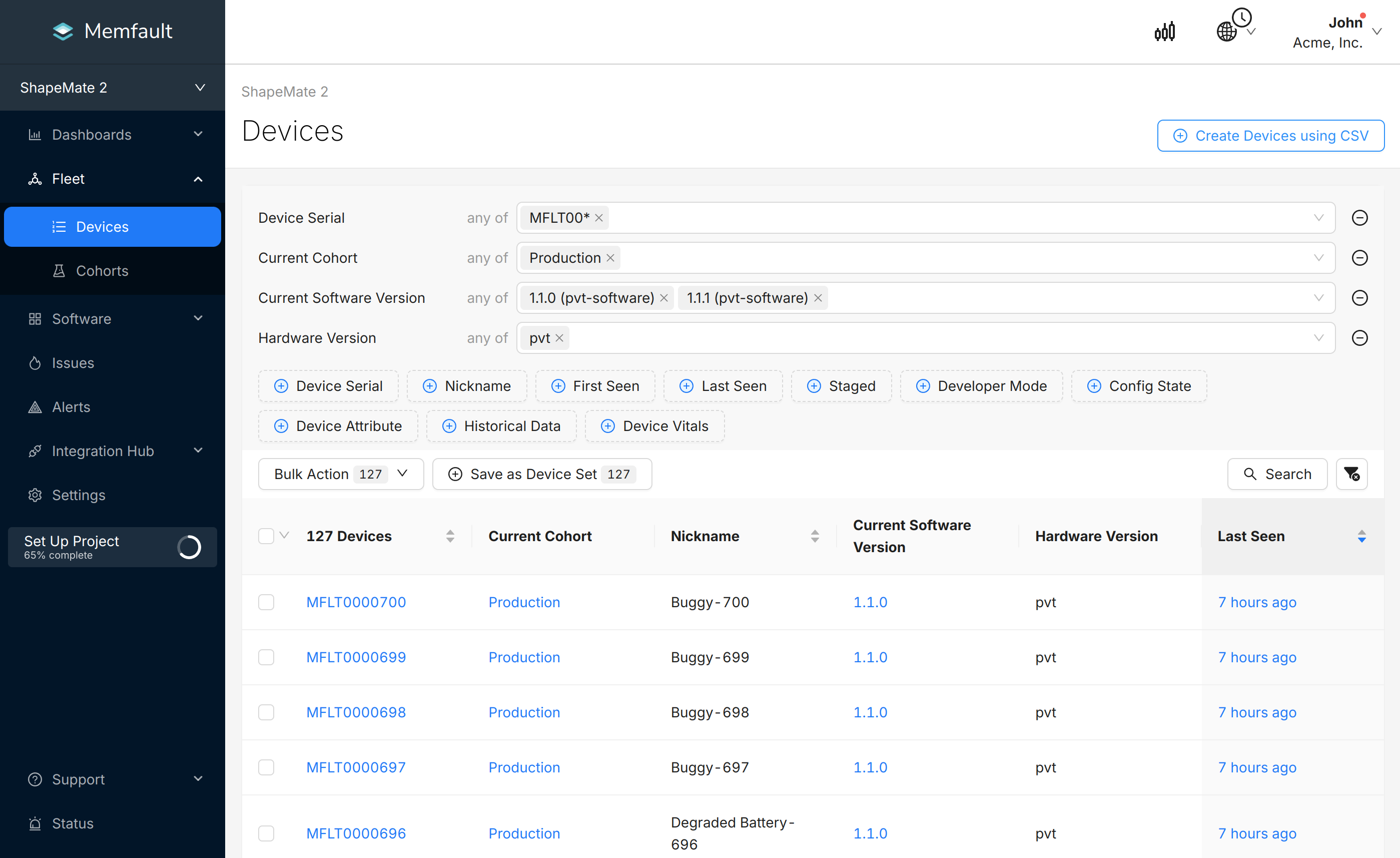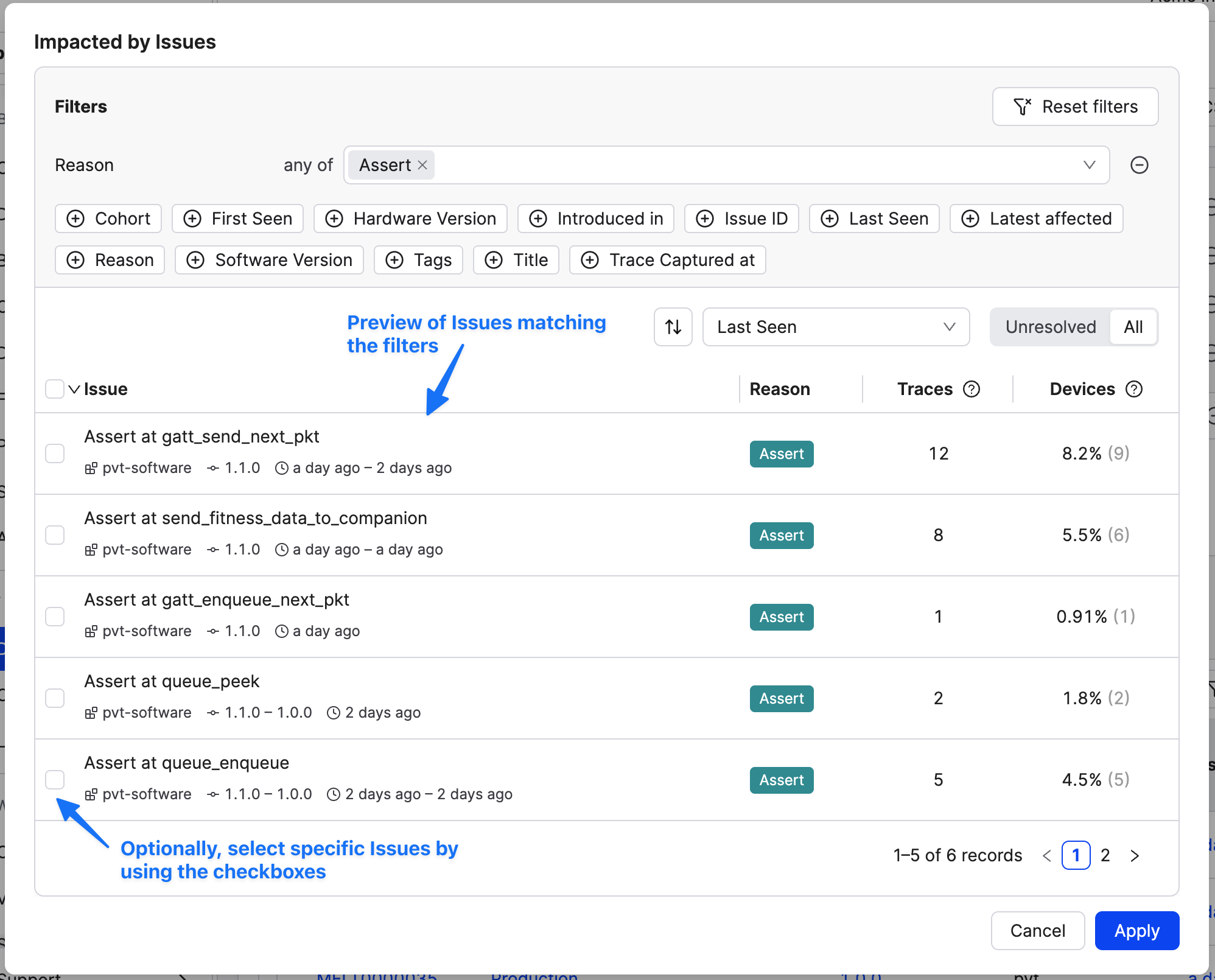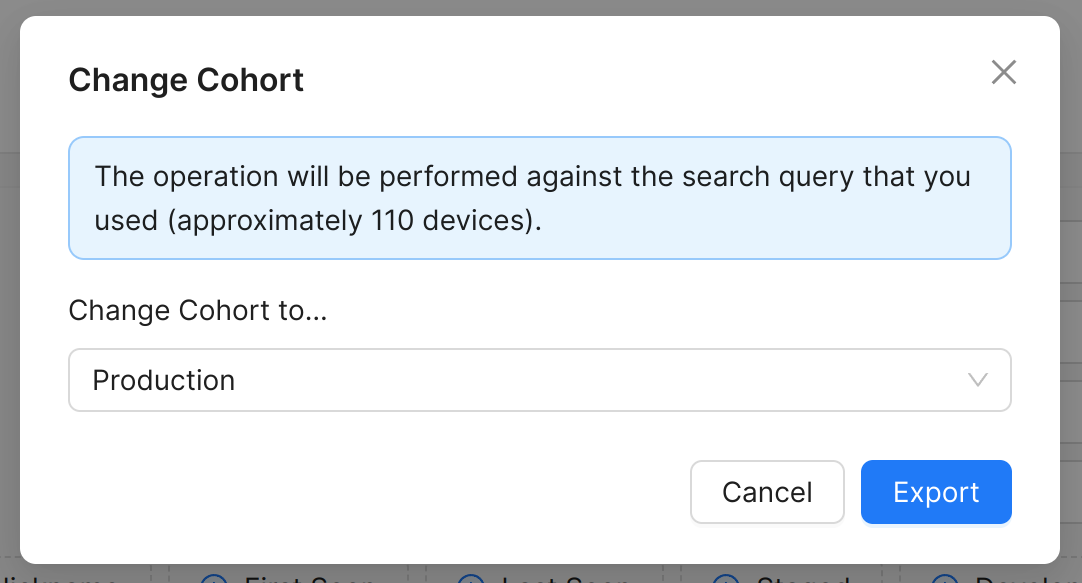Device Inventory
The Device Inventory provides access to all devices in your project. It can be found via Fleet → Devices. You can use it to perform the following tasks:
- Finding devices matching certain criteria
- Creating a Device Set chart to visualize the size of a population of devices over time
- Importing devices from a .csv file
- Exporting devices to a .csv file
- Bulk-changing properties of devices
- ... and more!

Device Inventory
Device Search
The Device Inventory has powerful filters that you can leverage to quickly find the devices you are looking for.
Each type of filter is explained below in more detail.
Wildcards
Some filters support using a * (wildcard) character at the beginning and/or
end of the search term:
*example: matches any term ending withexampleexample*: matches any term starting withexample*example*: matches any term containingexample
Note: the * character is not supported in the middle of the search term.
Combining Multiple Filters
When multiple filters are applied at the same time, they are combined with an AND operator. Some filters support entering multiple values, for example the Device Serial filter. In this case, an OR operator is used "within" that filter. In the example below, the search will return devices that have:
- Device Serial starting with
MFLTOR starting withACME - AND
- Device Serial ending with
88OR ending with55

Example of combining multiple filters
Searching Devices by Device Serial
One or more Device Serials or wildcards patterns can be used in this field.
The example below finds Devices with a Device Serial, matching MFLT0000013, or
starting with MFLT, or containing 15 or ending with 9:

Searching Devices by Current Cohort
One or more Cohorts can be used in this field.
The example below finds Devices that are currently in the Cohort Production or
Test:

Searching Devices by Nickname
An exact match or a wildcards pattern can be used in this field.
The example below finds Devices that have a Nickname starting with Buggy:

Searching Devices by Current Software Version
One or multiple Software Versions can be used in this field.
The example below finds Devices that are currently running Software Version
1.1.1 or 1.1.0:

Searching Devices by Hardware Version
One or multiple Hardware Versions can be used in this field.
The example below finds Devices that have the Hardware Version pvt:

Searching Devices by First/Last Seen
This filter can be used to find devices that have first or last been seen within a certain time frame, or have never been seen at all. The latter is possible in case devices have been imported via .csv but have not yet uploaded any data to Memfault.
The example below finds Devices that have been first seen between 2024-05-29 and 24-06-27 AND were last seen between 2024-06-21 and 2024-06-27:

Searching Devices by Staged-rollout Release
Select devices that are staged to receive a staged-rollout Release. See documentation on Over-the-Air Updates for more information.

Searching Devices by Developer Mode
Select devices that are in Server-Side Developer Mode. See documentation on Developer Mode for more information.

Searching Devices by Fleet Sampling Resolution
Select devices that have a specific Fleet Sampling Resolution. See documentation on Fleet Sampling for more information.
The example below finds Devices that have a Debugging Resolution of Normal
AND a Monitoring Resolution of Low or Normal AND a Logging
Resolution of Off AND a Sessions Resolution of Normal:

Searching Devices by Device Config State
This filter can be used to find devices based on the sync state of Device configuration (only applicable to Linux and Android SDKs). The Device configuration contains the settings that are applied to the device, such as Fleet Sampling Resolutions, dynamic SDK Settings, and more.

Searching Devices by Device Attributes
This filter finds devices by Device Attribute. Different operators can be used to filter by attributes. Only a single, literal value can be provided.
The example below finds Devices that have a Device Attribute region with the
value EU:

Searching Devices by Timeseries Metrics
This feature has been deprecated (you can't create that type of filter anymore). Please use the Report Count filter instead.
To filter by Timeseries, add a Historical Data filter and select Timeseries Metric.
When using multiple Timeseries Metric filters in a single Historical Data block, the conditions will be combined with an AND operator, but are not evaluated together on the same report, but independently. Also see the Report Count filter for filter that is more capable but also more complex.
The example below finds Devices that have uploaded between 2024-06-21 and 2024-06-27...
- a Heartbeat report with timeseries metric
chassis_temperature_celsiusgreater than50 - AND
- a Heartbeat report with timeseries metric
voice_command_countgreater than5:

Searching Devices by Report Count
To find devices based on the number of matching reports they have uploaded, add a Historical Data filter and select Report count.
This filter allows you to specify the type of report and the count of reports to filter by. In addition, you can add conditions on timeseries metrics to filter the reports by, before counting them. Up to 3 different timeseries metrics can be used in the conditions. It's possible to use the same metric multiple times.
All conditions are combined with an AND operator and operate together on each report (unlike when multiple Timeseries Metric filters are used).
The example below finds Devices that have uploaded between 2024-06-21 and
2024-06-27, at least 4 or more Heartbeat reports with timeseries metric
chassis_temperature_celsius greater than 50 AND voice_command_count
greater than 5:

Searching Devices by Device Vital
To find devices based on a Device Vital, add a Historical Data filter and select Device Vital.
This filter also allows you to add conditions to filter the reports by, just like the Report Count filter.
Optionally, filtering can be done on the Software Version that the reports were captured on.
The example below finds Devices that have an expected battery life of 10 hours or less, based on Heartbeat reports that have at have more than 1000 steps, were captured between 2024-06-21 and 2024-06-27, on Software Version 1.0.0 or 1.1.0:

Searching Devices by Reboot Reason
The example below finds Devices that have rebooted between 2024-06-21 and 2024-06-27 due to a "User Shutdown" or "Assert" reboot:

Searching Devices by Impacted Issues
This filter allows you to find devices that have been impacted by specific Issues or Issues matching certain filter criteria. Click the edit icon the filters or select specific issues:

The filter modal allows you to set detailed criteria for the Issues, including filtering by Reason, Trace count, and other Issue attributes. You can also optionally select specific issues by using the checkboxes:

Creating a Device Set Chart
See documentation on the Device Sets for more information.
Importing Devices from .csv
Click the "Create Devices using CSV" button to open the modal that allows you to upload a CSV file to create devices in bulk. Use the following format:
- Required columns:
device_serialandhardware_version. - Optional:
cohort.
The Cohort column
- Newly created devices without a value in the Cohort column will be added to
the
defaultCohort. - It must contain Cohort slugs (not Cohort display names). All Cohort slugs can be found Fleet → Cohorts
Bulk Actions
Bulk Action: Change Cohort
Using the "Bulk Action" -> "Change Cohort" menu, you can bulk-update the Cohort of all matching Devices at once. Use search filters to define the desired list of Devices first.

Bulk Action: Export
Using the "Bulk Action" -> "Export" menu, you can bulk export lists of Devices and associated information as a CSV file. Use search filters to define the desired list of Devices and then export that list as a CSV. Once the CSV is generated, it will be emailed to you. This makes it easy to share information on specific groups of Devices to teams in the organization outside Memfault for further processing in external tools or scripts for logistics, reporting, etc.
By default, on export the CSV will include basic information about the Device such as serial number, Cohort, software and Hardware Version etc. and a user can also choose to include Device Attributes in the export if required.
Bulk Action: Update Staged
Using the "Bulk Action" -> "Change Staged" you can change the staged flag of multiple Devices. The staged flag controls whether a Device can see the staged Releases that are activated its Cohort.
Normally, this flag is set automatically when you change the rollout percentage slider. However, that mechanism randomly picks devices while the bulk action allows for more control like deciding the order in which to mark Devices as staged.
Bulk Action: Update Fleet Sampling Resolution
This action allows you to set the aspect resolution of multiple devices at once and is explained in more detail here.
Deleting Devices
Devices can be deleted individually from the Device Details page, via the three-dots menu in the top-right corner:

Deleting a device is a permanent action and cannot be undone. All data associated with the device will be permanently removed from Memfault.
Performing this action requires admin level permissions.
Deleting devices in bulk is not supported at this time. If you need to delete many devices, please contact Memfault support for assistance.